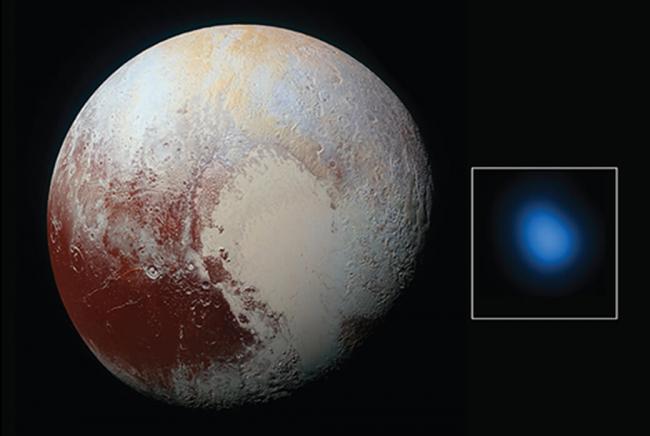Solar System
While astronomers have discovered thousands of other worlds orbiting distant stars, our best knowledge about planets, moons, and life comes from one place. The Solar System provides the only known example of a habitable planet, the only star we can observe close-up, and the only worlds we can visit with space probes. Solar System research is essential for understanding the origin and evolution of planets, along with the conditions necessary for life.
Our Work
Center for Astrophysics | Harvard & Smithsonian scientists study the Solar System in many ways:
-
Participating in current and next-generation astronomical surveys mapping a large part of the sky. The multi-year Pan-STARRS survey has revealed many comets, asteroids, and other small Solar System bodies.
Pan-STARRS Releases Largest Digital Sky Survey to the World -
Studying the Sun using probes and instruments on rockets. Much of the Sun’s radiation is blocked by Earth’s atmosphere, requiring the use of stratospheric rockets such as the Hi-C mission or solar probes like the Solar Dynamics Observatory (SDO). These missions allow researchers to observe the high-energy radiation driven by the Sun’s magnetic field.
Hi-C Launches to Study Sun's Corona -
Observing comets in X-ray light to understand the effect the Sun has on them. Using NASA’s Chandra X-ray Observatory, astronomers study the reactions of molecules on a comet’s surface and in its tails respond when bombarded by sunlight and high-energy particles from the solar wind.
Comets ISON & PanSTARRS: Comets in the ‘X’-Treme -
Using the Chandra X-ray Observatory to study the icy worlds of the outer Solar System. Pluto in particular reacts relatively strongly to particles from the solar wind, to the point where its atmosphere shows up in X-ray telescopes. That behavior is similar to what we see from Mars’ atmosphere, even though Pluto is much farther from the Sun.
X-ray Detection Sheds New Light on Pluto -
Studying the chemical composition of Earth’s Moon and other satellites. Using data from robotic space probes, researchers have discovered water on bodies throughout the Solar System, including the Moon. While many of these places were once thought to be dry, astronomers now know there is far more water around the Solar System than just on Earth.
Water on the Moon? -
Looking for new and possibly unexpected worlds at the edges of the Solar System. Some astronomers think there might be a large “Planet Nine” far beyond the orbit of Pluto, based on unexplained observed motion of icy worlds in the Kuiper Belt.
Planet Nine: A World That Shouldn't Exist
The Mysterious Worlds We Know Best
The heart of the Solar System is the Sun, a yellow star of moderate mass somewhere in the middle of its life cycle. That star is what drives most of the physical processes in the system, from heating Earth’s atmosphere to allow life, to gently pushing asteroids around and giving comets their tails. The rest of the Solar System is its eight major planets, five dwarf planets, hundreds of moons, and a large number of comets, asteroids, and other small bodies of rock and ice.
The extent of the Solar System is defined by the solar wind — particles driven by the Sun’s magnetic field — and gravitational influence. The heliopause is the boundary created when solar wind particles collide with interstellar gas as the Solar System moves through the galaxy. The gravitational edge is much farther and is defined by the Oort Cloud, a halo of icy debris left over from the formation of the Solar System. The Oort Cloud is the origin of many comets, and reaches nearly halfway to the nearest star.
As we’ve learned through centuries of study, the various planets, moons, and other objects in the Solar System are the products both of their common origin and of their unique history. Missions to Jupiter and Saturn have revealed that some moons might have habitable oceans beneath the ice. Comets and asteroids are the remaining planetesimals from the nebula that made the Solar System, which provide us with a look at the chemistry and physical processes that produced the planets.
Researchers use all that information to understand where we came from, and how the Solar System fits in with the thousands of known exoplanet systems. We can study the worlds of our Solar System in more detail than these alien planets, but no other star system so far resembles ours. The contrast between these systems and ours helps us understand the general rules governing planet formation and evolution.

Pluto's atmosphere is barely visible as seen in the optical light image captured by NASA's New Horizons spacecraft. However, in the inset X-ray picture from NASA's Chandra X-ray Observatory, the atmosphere shines out, revealing details about the environment of the outer Solar System.
Related News
Astronomers Discover Rare Distant Object in Sync with Neptune
Smithsonian Scientists Help Uncover How the Solar Wind Gets its Energy
CfA Celebrates 25 Years with the Chandra X-ray Observatory
Could Space Dust Help Protect the Earth from Climate Change?
Mars as a Base for Asteroid Exploration and Mining
The Orbital Flatness of Planetary Systems
Interstellar Comets Like Borisov May Not be All That Rare
Comet or Asteroid: What Killed the Dinosaurs And Where Did it Come From?
Growing Interest in Moon Resources Could Cause Tension, Scientists Find
Could Life Exist Deep Underground on Mars?
Telescopes and Instruments
1.2 Meter (48-inch) Telescope
Visit the 1.2-Meter (48 Inch) Telescope Website
1.5-meter Tillinghast (60-inch) Telescope
CfA Operated (OIR) | Open to CfA Scientists | Active
Visit the 1.5 Meter (60 Inch) Tillinghast Telescope Website
Parker Solar Probe
Visit the Parker Solar Probe SWEAP Website
The Submillimeter Array - Maunakea, HI
Visit the Submillimeter Array Website